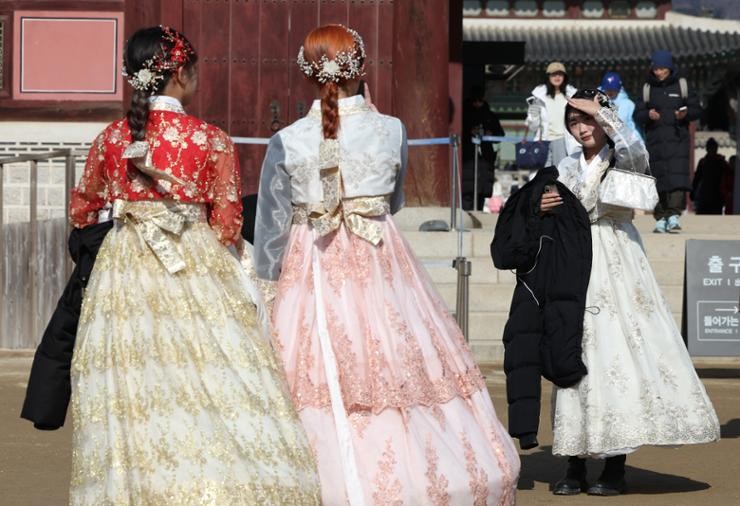
Chinese tourists' spending in Korea doubles from 2019
Latest
 |
| Travelers dressed in Korea's traditional attire hanbok visit Gyeongbok Palace in central Seoul, Sunday. Yonhap |
The Ministry of Culture, Sports and Tourism and the Korea Tourism Organization (KTO) held a forum on the new inbound tourism trend with around 200 industry and government officials in Seoul on Monday.
According to Trip.com Vice President Edison Chen, Chinese tourists' average spending on accommodation in Korea per night is around 1,000 to 2,500 yuan ($139 to 348), which is more than twice that of 2019.
Their expenditure on air travel and tour and experience programs also increased compared to 2019, but travel expenditures in general lag behind Japan, he noted.
"Chinese consumers on Trip.com spend [two] to three times more when purchasing Japan travel packages, compared to how much they spend to travel to Korea and Thailand," Chen said, adding that the company expects Japan's wide range of themed packages by seasons to be the reason behind its leading performance.
Jin Jong-hwa, the KTO's regional executive of China, said that Korea is seeing a "grand shift" in its inbound tourism trend, as young and trend-sensitive free, independent travelers (FIT) are growing in numbers.
The organization's latest survey of Chinese travelers aged 20 to 39 who visited Korea shows that their destination grew more diverse, as 30 percent of the respondents picked Jeju Island as their preferred destination, while 15 percent chose Busan.
This new group of travelers plan their trips based on information from social media and prefer to experience lesser-known local culture than landmark destinations traditionally visited by group tourists, Jin said.
Qiao Ling, the head of commercial travel at China's social media platform Xiaohongshu, said that young Chinese users interested in traveling to Korea, around 70 percent of whom are women aged 20 to 39, search keywords related to beauty, shopping, citywalks and visa application.
The statistics by BC Card reflect the shift from group tours to FITs.
The sources of Chinese travelers' spending in Korea are no longer limited to duty-free shops. They grew more diverse to include convenience stores, internet shopping and large retail stores.
They also began visiting other parts of Seoul, such as Seongsu-dong and Yeouido, away from the city's traditional tourist district in Myeong-dong, while the time of their spending shifted from daytime and afternoon to evening and nighttime.
The forum event also discussed the inbound tourism trend of Middle Eastern travelers.
Some 60 percent of the Middle Eastern travelers who visited Korea said that they were motivated by their interests in K-culture content such as K-pop and K-drama, according to the KTO's Dubai Office head Jung Ji-man.
Also, many come to explore the country's natural landscape, including mountains and oceans, he noted.
Industry officials pointed out that Korea needs to improve accessibility to regional destinations to accelerate the country's inbound tourism and attain the ambitious goal of reaching 20 million travelers this year.
Klook's business development manager, Moon Yong-soo, suggested that public transportation and reservation systems need improvement to attract foreign travelers.

















